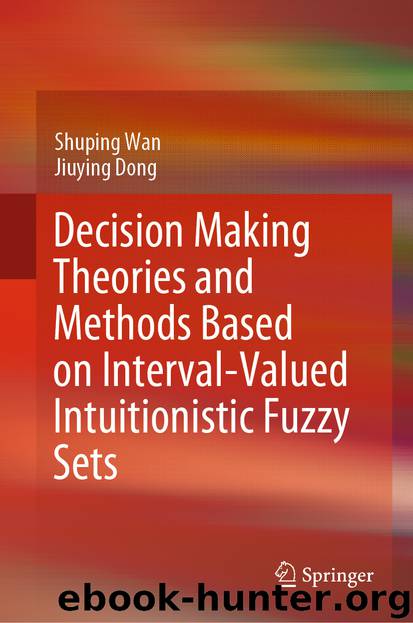Decision Making Theories and Methods Based on Interval-Valued Intuitionistic Fuzzy Sets by Shuping Wan & Jiuying Dong

Author:Shuping Wan & Jiuying Dong
Language: eng
Format: epub
ISBN: 9789811515217
Publisher: Springer Singapore
(5.37)
There are several methods to solve a multiple objective programming. Here, we apply membership function-based linear sum approach to solving Eq. (5.37). Suppose that and are the maximum and minimum values of the single objective function ignoring the other objectives in Eq. (5.37). The corresponding linear membership function of the objective function is defined as follows:
(5.38)
Then, Eq. (5.37) can be solved by the following linear programming model:
(5.39)
where is the weight of objective such that and . If the importance of different objectives is equal, the objective weights can take equal value, i.e., . It is easily seen that Eq. (5.39) is a linear programming model. Using the simplex method to solve Eq. (5.39), the attribute weight vector can be derived.
Remark 5.3
We establish a multi-objective IVIF programming model that maximizes the collective overall IVIF ratings of all alternatives to determine optimal weights of attributes. Moreover, this model is transformed into the equivalent linear programming model by using membership function-based linear sum approach. However, Jin et al. [8] constructed a programming model that minimizes the entropy values of alternatives, Zhang and Xu [41] presented a multi-choice linear programming model that maximizing the closeness indices. Wan et al. [14] established a multi-objective interval programming model based on the comprehensive values of alternatives, Based on the above analysis, the major difference is that the proposed model is a multi-objective IVIF programming model in which the objective is an IVIFN, which is well-suited to express the hesitancy degree inherent in DMs’ judgments, while the objectives in methods [8, 14, 41] are crisp values or interval numbers which cannot reflect the hesitancy degrees inherent in DMs’ judgments. Thus, the proposed model in this chapter may lead to much less information loss than that of methods [8, 14, 41] in the determination of the attribute weights.
Download
This site does not store any files on its server. We only index and link to content provided by other sites. Please contact the content providers to delete copyright contents if any and email us, we'll remove relevant links or contents immediately.
Bad Blood by John Carreyrou(6519)
Rich Dad Poor Dad by Robert T. Kiyosaki(6359)
Principles: Life and Work by Ray Dalio(6175)
Playing to Win_ How Strategy Really Works by A.G. Lafley & Roger L. Martin(5861)
Management Strategies for the Cloud Revolution: How Cloud Computing Is Transforming Business and Why You Can't Afford to Be Left Behind by Charles Babcock(4510)
The Confidence Code by Katty Kay(4173)
Thinking in Bets by Annie Duke(4140)
American Kingpin by Nick Bilton(3738)
Delivering Happiness by Tony Hsieh(3353)
Project Animal Farm: An Accidental Journey into the Secret World of Farming and the Truth About Our Food by Sonia Faruqi(3163)
The Power of Habit by Charles Duhigg(3044)
Brotopia by Emily Chang(2989)
The Tyranny of Metrics by Jerry Z. Muller(2982)
Mastering Bitcoin: Programming the Open Blockchain by Andreas M. Antonopoulos(2968)
The Marketing Plan Handbook: Develop Big-Picture Marketing Plans for Pennies on the Dollar by Robert W. Bly(2952)
I Live in the Future & Here's How It Works by Nick Bilton(2921)
The Content Trap by Bharat Anand(2850)
Applied Empathy by Michael Ventura(2828)
Building a StoryBrand by Donald Miller(2825)
